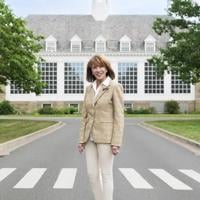Art
The Other Climate-Change Art Protest
“What is worth more: art or life?” That was the provocative question that the demonstrator Phoebe Plummer asked onlookers at London’s National Gallery last month. Seconds before, Plummer—along with another activist—had splattered tomato soup across Van Gogh’s Sunflowers, superglued one hand to the wall, and kneeled in front of the painting, facing museumgoers in a shirt emblazoned with JUST STOP OIL. In the subsequent weeks, more climate activists defaced other famous works of art at museums across Europe in stunt-y attempts to draw attention to the climate crisis. “A lot of people, when they saw us, had feelings of shock or horror or outrage,” Plummer told NPR. “Where is that emotional response when it’s our planet and our people that are being destroyed?”
The protesters may have succeeded in grabbing headlines, but their logic was puzzling. As my colleague Robinson Meyer has written, pitting concern for the climate against concern for protecting famous paintings makes little sense. In posing a false choice between art and the environment, the soup protesters backed themselves into a corner, attracting support from neither art lovers nor climate-movement sympathizers.
A better connection between art and climate change exists, and the people who know this best are those who live and work at its intersection: the niche community known as eco-artists.
Capturing the climate crisis in their work requires eco-artists to confront the daily realities of drought, heat, wildfires, and pollution. These conditions converge dramatically in the western states of the U.S., a region that has become synonymous with hazy tangerine skyscapes, charred remnants of forest, and cracked mosaic riverbeds. These images remind us that climate change is about loss—of species, of liveable conditions, of beauty. The climate crisis has inspired visual artists to create works that challenge viewers—and themselves—to move beyond shock and outrage, and toward action.
In Colorado, where wildfires are increasing in both intensity and frequency, Anna Kaye has used the changing landscape as reference scenes for her drawings and paintings. After moving to the state in the mid-2000s, she has repeatedly visited the burn zones of the 2002 Hayman Fire—one of the largest in Colorado’s history—to document the wreckage. In Kaye’s watercolor Bluebird and Mountain Dandelion, abstract streaks of brown, black, and green stand in for a tree reshaped by fire, while a detailed mountain bluebird and an orange dandelion perch atop the branches. “It’s incredible to see those slivers of grass that come back out and fight for life, and the roots that resprout and become new plants,” she told me. “There’s power in witnessing that regeneration.”

In contrast with her vibrant, delicate watercolors of the flora and fauna that repopulate burn zones, Kaye has also created large-scale charcoal drawings of fires that she’s witnessed, such as the Indian Gulch Fire, which destroyed 1,700 acres in 2011. “Fire is a challenging [subject] because with it comes trauma,” she said. The resulting drawings inspire optimism less readily; instead, they navigate the friction between the grandeur and terror evoked by large-scale flames.
For Kaye, painting and drawing are the practices that she believes allow her to process living through the climate crisis, but eco-art can also encompass music, poetry, dance, and literature. Perhaps America’s most famous eco-artist is the writer Rachel Carson, whom many consider the mother of the modern environmental movement. In 1962, Carson’s book Silent Spring laid out the harms that human pesticide use was wreaking on the natural world. But as Anelise Chen wrote in The Atlantic, Carson’s body of work was equally focused on inspiring awe at nature’s beauty. People need to feel invested in protecting what they love about the planet, not just sad about its destruction. Silent Spring’s publication may have been a much-needed wake-up call 50 years ago. Today, many people already recognize that climate change is a serious, pressing issue, yet scientists warn that humanity is not moving fast enough to mitigate the worst effects of the crisis. Eco-artists are now faced with a new challenge: How do you move people past their fatigue and grief, and galvanize action?
Kim Abeles has made a career out of trying to answer that question. For 35 years, she has produced art from molecules of Los Angeles smog by layering stencils over glass, wood, or fabric outside on her studio’s rooftop and allowing particulate matter to accumulate. Over time an image emerges providing a snapshot of the air quality during a particular stretch of days, weeks, or months. Abeles refers to these works as “smog collectors.” One of her motivations, she told me, is to make visible the pollutants that people breathe into their lungs every day. Abeles’s first smog collector, from 1987, traces the silhouette of the San Gabriel Mountains, 50 miles northwest from downtown L.A., which are often obscured by pollution. Over the decades that she’s lived in the L.A. metro area, the mountains have continued to fade in and out of sight, a reminder that Abeles’s work is never truly done.
From the beginning, criticism has been a core objective of Abeles’s smog collectors. Her 2019 addition, World Leaders in Smog, features smog portraits of 10 politicians alongside quotes from their environmental speeches, subverting the notion of “personal responsibility” in combating climate change. Yes, every person can work to reduce their carbon footprint but, Abeles feels, those measures pale in comparison with the harms that governments and fossil-fuel companies inflict on the Earth. “World leaders, corporate leaders—they’re individuals too,” she said. Former President Donald Trump’s portrait is accompanied by words from his 2017 speech withdrawing from the Paris climate accords: “The United States, under the Trump administration, will continue to be the cleanest and most environmentally friendly country on Earth.”

More than just protest or condemnation, Abeles told me, she wants to use her art to achieve tangible outcomes. Beyond museums, she has displayed her smog collectors in community centers and other public spaces. In the ’90s, the California Bureau of Automotive Repair commissioned her to create and display new smog collectors to encourage drivers to test their emissions and share rides. In another project, making smog collectors with Colorado middle schoolers, Abeles tried to encourage parents to stop idling their cars during afternoon pickup. “Typical data and graphs—how we’re often given material—doesn’t ever hit the emotional part that we really need to tap into,” she said. “I’m not trying to decorate this problem,” Abeles told me.
Indeed, eco-art doesn’t need to be housed in galleries or institutions to reach its intended audiences. For more than a decade, Michelle Glass has held textile workshops with residents of California’s Central Valley, where some of the most polluted cities in the country are located and where poor air quality and water contamination have jeopardized residents’ health. In recent years, the region has had the highest rates of asthma and asthma-related hospitalizations in the state. Like Abeles’s smog collectors, Glass’s works (made of natural dyes and fibers) strive to educate residents about the environmental harms in their backyards and then move them toward change. In her workshops, Glass uses local plants and tap water to dye fabrics—relying on the environment itself as the medium. She told me she finds art to be the most effective way to communicate with the women who attend her workshops—many of whom are older immigrants from Mexico—because it transcends language barriers. “You get the color story of the land. If you’re living in a healthy environment, the colors will be very rich and vibrant,” Glass said. “If you’re not … those colors will be very muted and dull.”

In early 2020, Glass started working on a project titled We Are Here/Estamos Aquí in collaboration with several environmental-justice organizations. Their goal was to make residents conscious of the dangers of living with pollution, and to harness that awareness into individual- and policy-level changes. More than 2 million California residents live within 2,500 feet (nearly half a mile) of an oil or gas well; the Central Valley’s Kern County, where Glass works, produces more than 70 percent of the state’s oil. Living near oil production sites can be hazardous to residents, with drilling exposing them to increased concentrations of air pollutants and wastewater from oil extraction contaminating groundwater sources. When this project started, the organizations had spent nearly 10 years lobbying state legislators to create a buffer zone between oil drills and residential communities without success.
Over the past two years, Glass and the workshop participants created more than 400 fabric panels stretching 2,500 feet: the distance of their proposed setback. They used reds, yellows, and greens—the colors of the air-quality index—and, on Earth Day this year, carried the tapestry in a procession along the Kern River Oil Field. Glass told me that though she believed the demonstration was a culminating moment, the workshops were equally meaningful, as residents learned the truth about their environment, reflected on ways they could reduce their own climate footprints, and contacted their representatives. In September, Governor Gavin Newsom signed into law a bill that will create a buffer zone of 3,200 feet between new oil wells and residents. The California Independent Petroleum Association has already raised $8 million to try to reverse the legislation. “The oil and gas companies and the large businesses are banking on the fact that we’re going to get tired,” Glass said.
But because Glass and other eco-artists believe that the well-being of entire communities and the planet is at stake, they’re committed to pressing ahead. The climate museum protesters don’t seem to be stopping anytime soon, either. Just this past Friday, activists threw flour over a sports car painted by Andy Warhol in Milan. As they become more frequent, the novelty of the museum protests will fade. Creating art, though, can still be a useful tool for the climate movement. “If you just alarm people or critique, we’re only complaining,” Abeles told me. “You have to give people somewhere to go.”
Art
Calvin Lucyshyn: Vancouver Island Art Dealer Faces Fraud Charges After Police Seize Millions in Artwork

In a case that has sent shockwaves through the Vancouver Island art community, a local art dealer has been charged with one count of fraud over $5,000. Calvin Lucyshyn, the former operator of the now-closed Winchester Galleries in Oak Bay, faces the charge after police seized hundreds of artworks, valued in the tens of millions of dollars, from various storage sites in the Greater Victoria area.
Alleged Fraud Scheme
Police allege that Lucyshyn had been taking valuable art from members of the public under the guise of appraising or consigning the pieces for sale, only to cut off all communication with the owners. This investigation began in April 2022, when police received a complaint from an individual who had provided four paintings to Lucyshyn, including three works by renowned British Columbia artist Emily Carr, and had not received any updates on their sale.
Further investigation by the Saanich Police Department revealed that this was not an isolated incident. Detectives found other alleged victims who had similar experiences with Winchester Galleries, leading police to execute search warrants at three separate storage locations across Greater Victoria.
Massive Seizure of Artworks
In what has become one of the largest art fraud investigations in recent Canadian history, authorities seized approximately 1,100 pieces of art, including more than 600 pieces from a storage site in Saanich, over 300 in Langford, and more than 100 in Oak Bay. Some of the more valuable pieces, according to police, were estimated to be worth $85,000 each.
Lucyshyn was arrested on April 21, 2022, but was later released from custody. In May 2024, a fraud charge was formally laid against him.
Artwork Returned, but Some Remain Unclaimed
In a statement released on Monday, the Saanich Police Department confirmed that 1,050 of the seized artworks have been returned to their rightful owners. However, several pieces remain unclaimed, and police continue their efforts to track down the owners of these works.
Court Proceedings Ongoing
The criminal charge against Lucyshyn has not yet been tested in court, and he has publicly stated his intention to defend himself against any pending allegations. His next court appearance is scheduled for September 10, 2024.
Impact on the Local Art Community
The news of Lucyshyn’s alleged fraud has deeply affected Vancouver Island’s art community, particularly collectors, galleries, and artists who may have been impacted by the gallery’s operations. With high-value pieces from artists like Emily Carr involved, the case underscores the vulnerabilities that can exist in art transactions.
For many art collectors, the investigation has raised concerns about the potential for fraud in the art world, particularly when it comes to dealing with private galleries and dealers. The seizure of such a vast collection of artworks has also led to questions about the management and oversight of valuable art pieces, as well as the importance of transparency and trust in the industry.
As the case continues to unfold in court, it will likely serve as a cautionary tale for collectors and galleries alike, highlighting the need for due diligence in the sale and appraisal of high-value artworks.
While much of the seized artwork has been returned, the full scale of the alleged fraud is still being unraveled. Lucyshyn’s upcoming court appearances will be closely watched, not only by the legal community but also by the wider art world, as it navigates the fallout from one of Canada’s most significant art fraud cases in recent memory.
Art collectors and individuals who believe they may have been affected by this case are encouraged to contact the Saanich Police Department to inquire about any unclaimed pieces. Additionally, the case serves as a reminder for anyone involved in high-value art transactions to work with reputable dealers and to keep thorough documentation of all transactions.
As with any investment, whether in art or other ventures, it is crucial to be cautious and informed. Art fraud can devastate personal collections and finances, but by taking steps to verify authenticity, provenance, and the reputation of dealers, collectors can help safeguard their valuable pieces.
Art
Ukrainian sells art in Essex while stuck in a warzone – BBC.com
[unable to retrieve full-text content]
Ukrainian sells art in Essex while stuck in a warzone BBC.com

Source link
Art
Somerset House Fire: Courtauld Gallery Reopens, Rest of Landmark Closed
The Courtauld Gallery at Somerset House has reopened its doors to the public after a fire swept through the historic building in central London. While the gallery has resumed operations, the rest of the iconic site remains closed “until further notice.”
On Saturday, approximately 125 firefighters were called to the scene to battle the blaze, which sent smoke billowing across the city. Fortunately, the fire occurred in a part of the building not housing valuable artworks, and no injuries were reported. Authorities are still investigating the cause of the fire.
Despite the disruption, art lovers queued outside the gallery before it reopened at 10:00 BST on Sunday. One visitor expressed his relief, saying, “I was sad to see the fire, but I’m relieved the art is safe.”
The Clark family, visiting London from Washington state, USA, had a unique perspective on the incident. While sightseeing on the London Eye, they watched as firefighters tackled the flames. Paul Clark, accompanied by his wife Jiorgia and their four children, shared their concern for the safety of the artwork inside Somerset House. “It was sad to see,” Mr. Clark told the BBC. As a fan of Vincent Van Gogh, he was particularly relieved to learn that the painter’s famous Self-Portrait with Bandaged Ear had not been affected by the fire.
Blaze in the West Wing
The fire broke out around midday on Saturday in the west wing of Somerset House, a section of the building primarily used for offices and storage. Jonathan Reekie, director of Somerset House Trust, assured the public that “no valuable artefacts or artworks” were located in that part of the building. By Sunday, fire engines were still stationed outside as investigations into the fire’s origin continued.
About Somerset House
Located on the Strand in central London, Somerset House is a prominent arts venue with a rich history dating back to the Georgian era. Built on the site of a former Tudor palace, the complex is known for its iconic courtyard and is home to the Courtauld Gallery. The gallery houses a prestigious collection from the Samuel Courtauld Trust, showcasing masterpieces from the Middle Ages to the 20th century. Among the notable works are pieces by impressionist legends such as Edouard Manet, Claude Monet, Paul Cézanne, and Vincent Van Gogh.
Somerset House regularly hosts cultural exhibitions and public events, including its popular winter ice skating sessions in the courtyard. However, for now, the venue remains partially closed as authorities ensure the safety of the site following the fire.
Art lovers and the Somerset House community can take solace in knowing that the invaluable collection remains unharmed, and the Courtauld Gallery continues to welcome visitors, offering a reprieve amid the disruption.
-

 Sports24 hours ago
Sports24 hours agoFledgling Northern Super League adds four to front office ahead of April kickoff
-

 News24 hours ago
News24 hours agoRCMP warn of armed robbery suspects west of Edmonton
-

 Sports13 hours ago
Sports13 hours agoEdler to sign one-day contract to retire as a Vancouver Canuck
-

 Sports20 hours ago
Sports20 hours agoSixth-ranked Canadian women to face World Cup champion Spain in October friendly
-

 News23 hours ago
News23 hours agoByelection win: Bloc Québécois to squeeze Liberals for gains, not trigger election
-

 Business24 hours ago
Business24 hours agoThe #1 Skill I Look For When Hiring
-

 News23 hours ago
News23 hours agoMila Mulroney named chancellor of St. Francis Xavier University in Antigonish, N.S.
-

 News20 hours ago
News20 hours agoReport charts path for Canada to show importance to United States





















